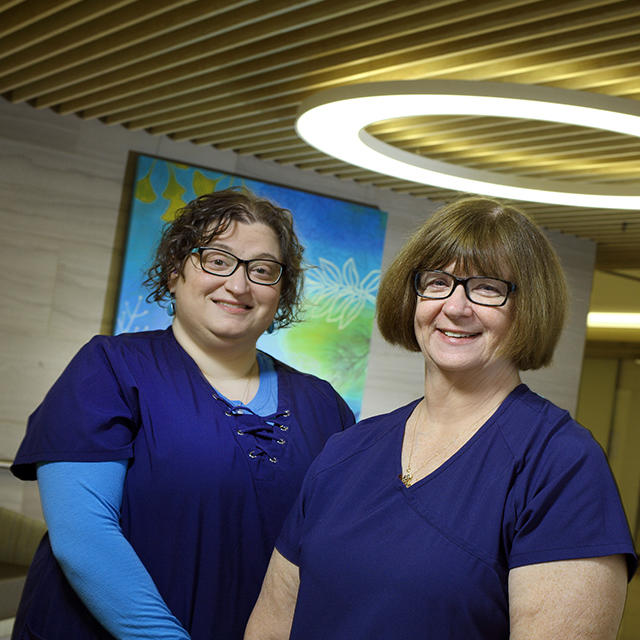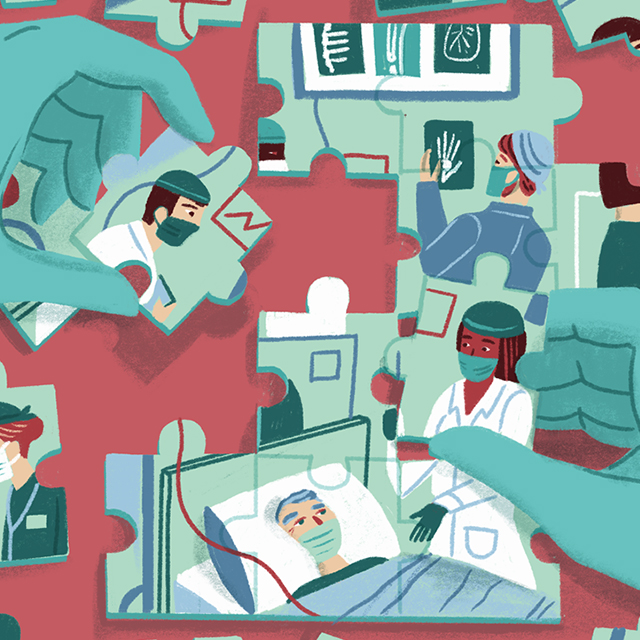Nurses at The Johns Hopkins Hospital are bolstering hospitalwide efforts to create a post-pandemic normal by continuing their long tradition of innovating, collaborating and driving improvements to clinical operations.
In 2022, for instance, Johns Hopkins nurses created new programs to improve their teams’ feelings of community and well-being. They also updated and strengthened models for educating new nurses and supporting them in their early days on the job.
Contributing to patient safety, they improved methods of protecting patients against catheter-associated urinary tract infections and hospital-acquired pressure injuries. They also implemented new protocols to expedite the process of patient discharge from the hospital.
In recognition of Nurses Week, here are a few key stories that will be highlighted in the upcoming 2022–23 Johns Hopkins Hospital Nursing Annual Report.
Creating a Culture of Support
Nurses aren’t accustomed to prioritizing their own well-being, says Carolyn Cumpsty-Fowler, senior director for nursing well-being at the Johns Hopkins Health System.
“There’s an enculturated belief that we are here to serve and that no matter what we are feeling, we’re supposed to tough it out, even if our well-being is compromised,” she says. “In reality, nurses’ well-being is foundational to achieving what we care about most — safe patient care and positive outcomes. That’s why Deborah Baker, senior vice president for nursing for the Johns Hopkins Health System, has made it a priority that we work to embed well-being into our nursing practice environments.”
To that end, Cumpsty-Fowler and her colleagues at the Johns Hopkins Medicine Office of Well-Being — established in 2018 “to create a more productive, joyful and healthful workplace” — dispensed nearly 100 small grants ($500 to $2,000) in 2022 to teams throughout the health care system that had come up with creative ideas for promoting well-being.
“These grants also encouraged the convening of small teams whose well-being projects helped create a culture of connection and support,” she says. “Feeling connected and supported at work is important for our individual and team well-being.”
Michelle Petinga and her colleagues felt a need for renewal and reconnection. Petinga, a Johns Hopkins nurse since 2014 who serves as the team’s clinical informatics coordinator, was dismayed when a survey indicated that more than one-third of Johns Hopkins nurses didn’t believe the institution cared about their well-being.
“I thought, ‘What if we could create a committee to promote well-being in Ambulatory Services?’”
The response was so enthusiastic, she ended up with committee co-chairs Kylee Gerohristodoulos, Natasha Hilton, Aly Stolba and Scott Goff. They decided to apply for one of the Office of Well-Being’s small grants (in this case, $1,000) to fund a series of events promoting the idea of well-being through seed planting. “It was something fun, and kind of represented what we want for our ambulatory team — to plant the seed of well-being,” says Gerohristodoulos.
When the committee told its story at the 2022 Johns Hopkins Ambulatory Nursing Conference, Petinga says the interest was phenomenal.
“It’s clear there is a real need to think about well-being and what we can do together to create a work environment that supports it. People are really hungry for this.” – Joan Cramer
Under Pressure: Lowering the HAPI Risk
Hospital-acquired pressure injuries (HAPIs) occur when patients spend prolonged time in bed without proper movement or turning. At The Johns Hopkins Hospital, nurses and clinical technicians use an evidence-based tool known as the Braden Scale to assess risk for and to prevent pressure injuries by turning or moving patients at regular intervals. But for nurses who work in critical care and psychiatric units, turning is not always safe or possible, making the Braden Scale an incomplete solution.
“Many prone patients who are very sick are not stable enough to be turned,” says Alphie Rahman, a clinical nurse specialist in the medical intensive care unit (MICU) of The Johns Hopkins Hospital. “Turning a patient with tachycardia, for example, can cause a life-threatening arrythmia.”
Rahman worked with Brenda Wells, a doctoral student at the Johns Hopkins University School of Nursing, to review the research literature on turning and to create new guidelines for adult patients whose condition is not stable. The guidelines, now part of the Wound Care Policy at Johns Hopkins Medicine, provide valuable information regarding interventions, monitoring and prevention of HAPIs through a more nuanced approach to turning or moving critical care patients. They also include clinical indications (like active hemorrhaging) that indicate when a patient shouldn’t be turned.
Since implementing the new guidelines roughly a year ago, the MICU has seen a significant drop in HAPI rates. Nurses in other units have created new preventive practices too. Lead clinical nurse Latanya Johnson-Strong helped develop guidelines for patients in the psychiatric unit, Meyer 6, who suffer complicated neuropsychiatric conditions that cause both psychological distress and chronic pain. “Many of our patients are bedridden, and movement can cause pain,” says Johnson-Strong, who adds that patients can exhibit extreme agitation in reaction to turning attempts.
To prevent injuries, Johnson-Strong created a methodology that starts with a head-to-toe assessment of wounds as soon as a patient enters the psych ward. If nurses or technicians suspect a wound, they alert Johnson-Strong, who helps monitor the situation, and if the wound progresses, they bring in Kelly Heffron, a nurse who specializes in wound care.
These efforts have paid off: Since the new system was implemented in early 2022, Meyer 6 has experienced no pressure injuries.
–Emily Gaines Buchler
Reducing CAUTI Rates in ICUs
Nurses play a critical role in preventing catheter-associated urinary tract infections (CAUTIs), which cost hospitals money to treat — and can cost patients their lives. At The Johns Hopkins Hospital, nurses in the neurosciences critical care unit (NCCU) and surgical intensive care unit (SICU) are taking innovative steps to reduce CAUTI rates, which rose across the nation during the peak of the coronavirus pandemic, due in part to the prolonged catheterization of some patients with COVID-19.
Betsy Zink, a clinical nurse specialist in the NCCU, realized her team needed stronger CAUTI preventive measures, but also understood the unique challenges of her unit, where catheters are a necessity for some patients who are immobile. Moreover, “our patients suffer from things like strokes, spinal cord injuries and brain aneurysms, and can’t always tell us they’re having flank pain or other symptoms of a urinary tract infection,” Zink explains.
In their most recent attempt to drive down stubbornly high CAUTI rates in the NCCU, Zink and colleagues Michelle Kouneski and Kristel Tenorio, staff nurses, and members of the NCCU CAUTI prevention committee scoured the research on CAUTI preventive measures and found one that involves wiping down patients with chlorhexidine gluconate (CHG), an antiseptic, two times a day from their naval to their knees. Clinical staff also use CHG wipes to clean the catheter insertion area and to cleanse patients after a bowel movement.
When Zink presented the measure to nursing staff members in fall 2021, “they were instrumental in getting it off the ground and ultimately took off running with it,” she says of the registered nurses who championed the effort: Tenorio, Eileen Sevilla, Stephanie Camphor and Michelle Caulkins. After 10 months of implementing the measure as standard procedure, the NCCU saw a 52% CAUTI reduction.
In the SICU, nursing teams faced similar challenges with CAUTIs, including an increase in urinary tract infections during the COVID-19 pandemic. SICU leaders appointed two nurses to champion the CAUTI effort, Alexander Sherman and Brittany Bellardino. They created and dispersed educational materials on best practices in culturing urine and other CAUTI-related topics, and started requiring clinical staff members in the SICU to attend mandatory CAUTI education and training sessions. The result is zero incidences of CAUTI for an entire year.
Symone Everett-Day, a clinical nurse specialist in the SICU, notes that such efforts are part of the larger patient-centered culture at Johns Hopkins. “The safety culture is engrained in everything we do, and it’s rewarding to see the efforts pay off,” she says. –Emily Gaines Buchler
Nurses Leading the Charge to Early Discharge
Plenty of holdups can get in the way of discharging patients from the hospital in a timely fashion. For instance, one patient might face a medication delivery delay, while another waits for imaging or lab results, and a third needs time with a nurse for extensive discharge instructions.
These and other impediments clog the flow of incoming and outgoing patients at hospitals across the country, including The Johns Hopkins Hospital, slowing the speed at which patients from the outside world, the emergency department, the post-anesthesia care unit and other places can receive a hospital bed and start receiving the necessary care.
To improve the stream of beds available at The Johns Hopkins Hospital, Pete Travers, the interim program director in bed management for the hospital’s Capacity Command Center, worked with an interdisciplinary team to launch the Aligned Early Discharge Initiative (previously known as Two by Noon), a program that involves discharging two patients on each hospital unit by noon every day.
The initiative started with a staggered rollout in June 2022, beginning with Zayed 11 East, where patients recuperate from orthopaedic, spine, trauma-related and general surgery; Zayed 11 West, the recovery unit for urology and thoracic surgery; and Zayed 10 West, the cardiovascular progressive care unit. Eventually, Travers and her team plan to implement the Aligned Early Discharge Initiative in all units across the hospital.
Most hospitals have an overarching discharge strategy, but “what makes our plan unique is that nurses lead the charge,” explains Travers. “When a patient is identified as ‘early discharge,’ the nurse nudges individuals in other disciplines to complete their part of the discharge process ahead of time, instead of scrambling at the last minute.”
Key to the initiative’s success, Travers says, is gathering data and identifying bottlenecks in the discharge process. “We track every component, and nurses get real-time data on potential impediments that they can use to troubleshoot.”
So far, the effort to equip nurses with the data they need to lead and coordinate the discharge process is paying off. For example, on 11 West, an average of 17% of patients previously left before noon. That jumped to 37% in December 2022, six months after the rollout of the initiative.
In the Department of Medicine, where the initiative recently rolled out, results are already strong. “We’re seeing patients move more quickly from the emergency room to a private hospital room, where they can get more robust care and ultimately have a better outcome,” Travers says.
In addition to making room for more patients, the Aligned Early Discharge Initiative is improving satisfaction rates. “No patient or family likes spending a longer amount of time in the hospital than is necessary,” says Leigh Massey, a nurse on Zayed 11 West. –Emily Gaines Buchler



